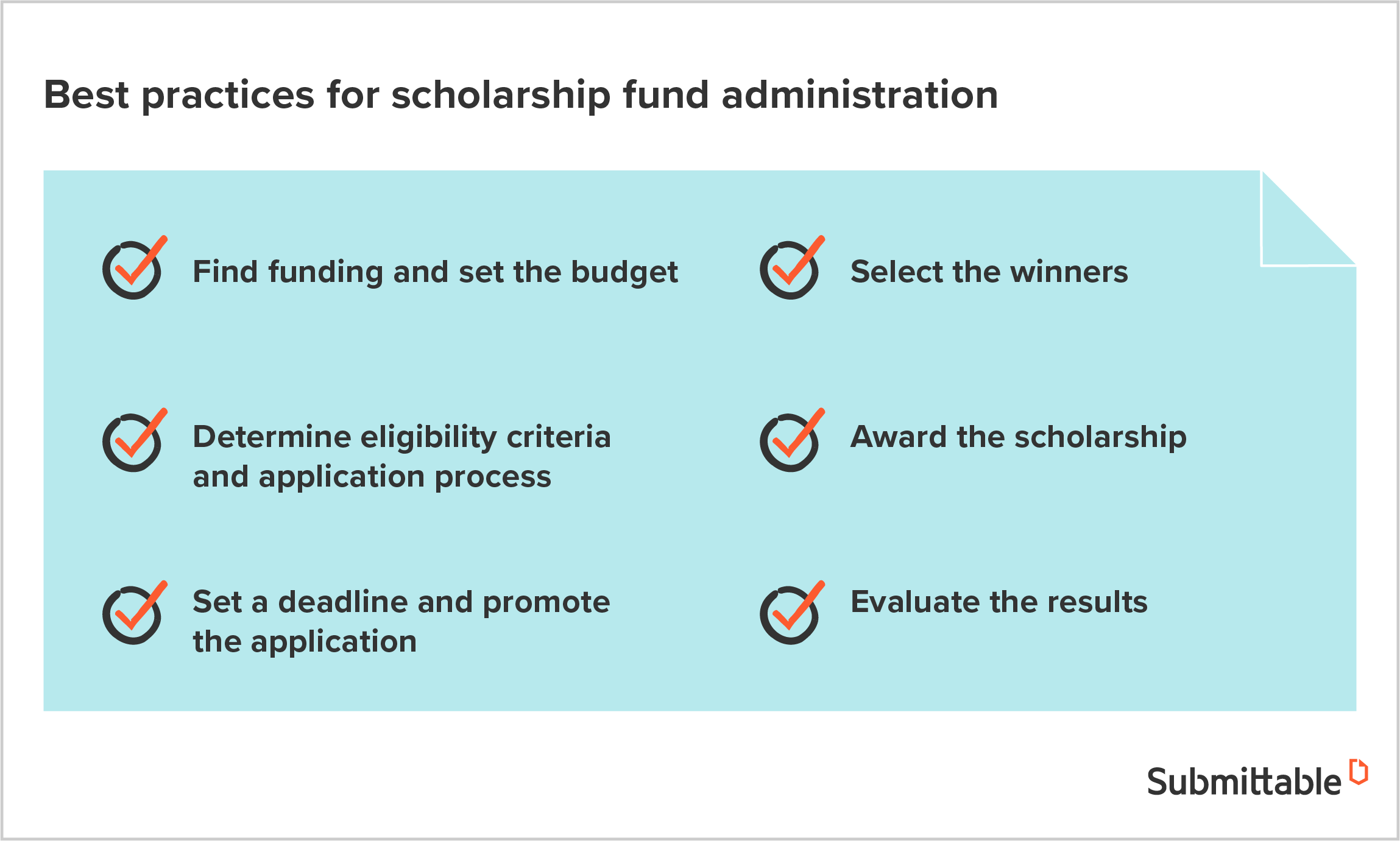There’s something special about the smiles on students’ faces at graduation.
Everyone knows it. We all feel it.
That tremendous sense of accomplishment. The feeling of hard work paying off.
Awarding scholarships to deserving students is a close second to that special moment—and for many, graduation would never happen if a scholarship didn’t come first.
But before we even get to those smiles, there are many complex processes that make both moments possible. From setting selection criteria and sourcing applicants to reviewing submissions and reporting outcomes, the work of managing a scholarship fund is deep.
Scholarship fund administrators are always working with students on top of mind. The goal is to maximize the impact of those funds in support of diligent scholars. Done right, everyone wins: students pursue their dreams, schools achieve their goal of education, and we all benefit from the work and research that the student will produce for a lifetime to come.
In order to improve the experience of the ultimate beneficiary of scholarships—the students—the entire process of administering scholarship funds should be evaluated and streamlined.
Let’s take a look at how modern managers of scholarship funds are getting that job done.
Mastering the basics of scholarship fund administration

1. Find funding and set the budget
There’s no scholarship without a pot of funds to draw from.
The big first step in scholarship fund administration is securing the dollars and establishing a budget. (We’ve published insights on how to start a scholarship fund.) At the outset, you’ll want to determine if you will administer the scholarship directly or use a scholarship management service.
Administering the scholarship directly will of course take up considerable time and resources from within your organization but you’ll exercise full control over the quality of scholarship management. That’s a big advantage.
With a scholarship management service, you can tap into the expertise of seasoned scholarship administrators and save time, but there will be a significant financial cost and there’s no guarantee of better results.
Scholarship funds often have specific requirements such as eligibility criteria and disbursement schedules–particularly when the funds come from a specific private donor. These requirements must be followed when administering the scholarships.
Outlining a clear budget allows you to determine how many students will benefit from the scholarship as well as plan for future management of scholarship funds.
This is the step where you set the table for the meal to come.
2. Determine eligibility criteria and application process
This is where the “who” of scholarships comes into play.
Determine who you would like to help—and be transparent about why you’ve chosen this slice of the student population. At this step, it’s important to have a representative group of decision-makers on your team determining the priorities for the scholarship. That’s the best way to ensure equity.
Whether it’s a group of students that have been historically marginalized in the admissions process or a specific discipline that’s being supported, be sure to articulate the why behind who you’re giving scholarship funds.
That’s the overall purpose of your scholarship. It’s the heart of it all.
Some factors you might want to consider are where the scholarship funds are coming from, current needs among the student population, and larger organizational priorities such as the need to attract and support students in certain areas of study.
Once you’ve settled on a target population, lay out explicit criteria for how winners will be chosen. Remember that applicants will look closely at these criteria and will even shape their applications to cater to it, so make sure that it aligns with your overall purpose.
With a clear purpose and specific criteria for selection laid out, it’s time to determine the applications process.
These days, it’s a good idea to use electronic applications to reduce paperwork, save time, and reduce errors. You can still offer paper applications as a backup along with other accommodations for applicants who might have limited access to digital platforms.
But for your backend management of the application process, your team will benefit greatly from a centralized platform for organizing submissions.
Make sure your application procedures are straightforward for applicants. Simplify the design of the application form so that you’re collecting only the most essential student information. For example, applicants shouldn’t have to enter the same biographical information multiple times. And the answers you get from applicants should help you make better awarding decisions over the long run.
Your application should be long enough to collect all the information you need, but not so involved that it dissuades people from applying in the first place.
If this isn’t the case, rethink (and revise) those application questions.
3. Set a deadline and promote the application
A clear deadline helps all parties.
For applicants, they’ll need to get good at juggling different (and often competing) deadlines across multiple scholarship applications, courses, and other personal and professional commitments.
For scholarship administrators, a deadline helps separate out applicants that can manage such timelines from those that perhaps aren’t as prepared to receive the scholarship. Deadlines also help administrators stay on course to accomplish all of their tasks in a timely manner, including reviewing, awarding, and reporting on their scholarship before next year’s or next semester’s cycle starts.
Along with a strategic deadline, scholarship administrators should put considerable time and effort into promoting the scholarship. Especially with scholarships that look to boost representation among previously disadvantaged groups, administrators will need to proactively connect with specific communities in order to build a strong pool of applicants.
With organizations competing for talent at an increasingly frantic pace, posting a few headlines about scholarship opportunities on your organization’s website just isn’t enough these days—not if you want the top students walking through your doors on orientation day.
If the students you’re looking to attract are living on social media, get creative and get on TikTok and Instagram to promote your scholarship. Find the right online forums and student organizations where you can share funding opportunities. Get connected to parent networks full of eager moms and dads looking for ways to support their child’s higher education.
The ideal spots to promote scholarships are out there, you just have to dig a little.
4. Select the winners
Reach back to the purpose of the scholarship and the selection criteria.
Let those two pillars guide you as you seek out the students best suited for the scholarship. This is also a way to ensure that all applicants are judged according to the same scale—an important equity consideration.
As submissions are being evaluated, keep up communication with applicants to let them know precisely how applications are being evaluated while setting out a clear timeline for notifications. Few things are more disheartening to hardworking students seeking financial support for their education than to be left in the dark without a sense of where they stand.
When it comes to announcing the winners, offer a personal touch.Whether it’s an actual phone call from an administrator or a personalized email encouraging applicants to push forward with their hard work, a little bit goes a long way.
Sending a form email in response to often deeply personal scholarship applications that took hours to construct is certainly less than professional and scholarship administrators can do better with just a little extra effort.
Unless you are dealing with mountains of submissions, taking the time at this stage will lead to better applicants down the line.
5. Award the scholarship
This is where the giving gets good.
Be sure to understand students’ specific financial situations and don’t be afraid to be flexible with disbursement timelines when awarding the scholarship.
Articulate why specific students were selected as well as how their selection in this particular year furthers the purpose of the scholarship. This is also a good opportunity to loop in past alumni that have received the scholarship in order to make a meaningful connection between various classes and generations of recipients.
Such links add a bit more meaning to an extremely important moment in students’ academic careers.
Also, don’t be afraid to take an extra step in support of the students that were not selected.
Scholarship administrators often have a solid scan of the universe of scholarship funds out there. Put it to use. Refer applicants to other scholarships that might be a good fit for them during and after the application process for your specific scholarship.
Whether the scholarship sits within your institution or another organization, don’t hesitate to spread the wealth and enrich the pool of applicants across the board.
6. Evaluate the results
Managing a scholarship fund shouldn’t be a shot in the dark.
With the right giving purpose and clear criteria for selecting recipients, it should be clear year over year whether the scholarship is achieving its intended results.
One way to help understand the impact of scholarships is for scholarship administrators to use modern technology for scholarship submissions and evaluation. With all of your applicant and recipient data in one place, you can track trends over time and better understand the applicant pool, how exactly scholarships funds were used, and how students who received awards fared overall.
Using this data, you’ll want to tweak the scholarship program from year to year. Even the best scholarships can get stale over time. Leveraging this information can help scholarship administrators respond to changing trends among students and educational awards generally.
Managing a scholarship fund with one centralized platform

Scholarship fund administration is much more than just cutting checks.
From devising selection criteria for applicants and promoting the scholarship application to notifying recipients about their award to evaluating the overall results of fund disbursements, getting scholarships right is complex business.
Scholarship administrators are often buried in applications and easing their burdens is one of the keys to improving how scholarships are given to students.
With the right centralized platform for managing submissions, scholarship administrators using Submittable have reported time savings of up to 10 hours per week. That time can be put towards refining selection criteria and promoting scholarship applications within communities that might not otherwise have access to such funds.
Help your scholarship selection committee streamline and modernize the whole administration of scholarship funds with scholarship management software that transforms how they do their work.
